Jaisalmer
| Jaisalmer | |
|---|---|
| City | |
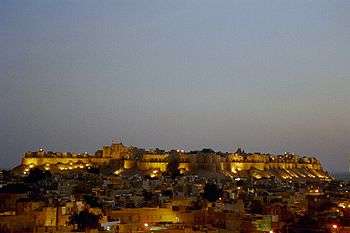 View of the Jaisalmer Fort in the evening. | |
 Jaisalmer Location in Rajasthan, India  Jaisalmer Jaisalmer (India) | |
| Coordinates: 26°54′47″N 70°54′54″E / 26.913°N 70.915°ECoordinates: 26°54′47″N 70°54′54″E / 26.913°N 70.915°E | |
| Country |
|
| State | Rajasthan |
| District | Jaisalmer |
| Founded by | Rawal Jaisal |
| Government | |
| • Jila pramukh | Anjna Meghwal |
| • M.L.A. | Mr. Chotu Singh Bhati |
| • District Collector & District Magistrate | Om Prakash Kasera, IAS |
| • Superintendent of Police | Jagdish Chandra Sharma, IPS |
| Area | |
| • Total | 5.1 km2 (2.0 sq mi) |
| Elevation | 225 m (738 ft) |
| Population (2011) | |
| • Total | 65,471 |
| • Density | 13,000/km2 (33,000/sq mi) |
| Languages | |
| • Official | Hindi and Rajasthani |
| Time zone | UTC+5:30 (IST) |
| PIN | 345 00x |
| Telephone code | 02992 |
| ISO 3166 code | RJ-IN |
| Vehicle registration | RJ-15 |
| Website |
jaisalmer |
| UNESCO World Heritage site | |
| Official name | Jaisalmer Fort |
| Part of | Hill Forts of Rajasthan |
| Criteria | Cultural: (ii)(iii) |
| Reference | 247rev-006 |
| Inscription | 2013 (37th Session) |
| Area | 8 ha (0.031 sq mi) |
| Buffer zone | 89 ha (0.34 sq mi) |
Jaisalmer ![]()
Origin of name
Jaisalmer is named after the Maharawal, Jaisal Singh, a Rajput king who founded the city in 1156 AD.[1] "Jaisalmer" means "the Hill Fort of Jaisal". Jaisalmer is sometimes called the "Golden City of India" because the yellow sandstone used throughout the architecture of both the fort and the town below, imbues both with a certain golden-yellow light.
Location
It is the largest district of Rajasthan and 3rd largest district by territorial region in the country, hugged on the west & south-west by the Pakistani border. The length of the international border attached to Jaisalmer District is 471 km (293 mi).
Geography and climate
Jaisalmer, being an arid desert region, is prone to extremes in terms of temperature. The temperature varies greatly from day to night in both summer and winter. The maximum summer temperature is around 49 °C (120 °F) while the minimum is 25 °C (77 °F). The maximum winter temperature is usually around 23.6 °C (74.5 °F) and the minimum is 5 °C (41 °F). The average rainfall is 209.5 millimetres (8.25 in).[2] Highest ever recorded temperature was 50.0 °C (122.0 °F);[3] the lowest ever recorded temperature being −5.9 °C (21.4 °F).[4] Temperatures of up to 52.4 °C (126.3 °F) have been recorded near the international border close to Pakistan, but standard conditions of this temperature recording remain unverified.[5]
Water is scarce, and generally brackish; the average depth of the wells is said to be about 250 feet (76 m). There are no perennial streams, and only one small river, the Kakni, which, after flowing a distance of 48 kilometres (30 mi), spreads over a large surface of flat ground, and forms Lake Orjhil ("The Bhuj-Jhil"). The climate is dry. Throughout Jaisalmer only raincrops, such as bajra, jawar, motif, til, etc., are grown; spring crops of wheat, barley, etc., are very rare.
Economy

Tourism is a major industry in Jaisalmer.
The Government of India initiated departmental exploration for oil in 1955–56 in the Jaisalmer area.[6] Oil India Limited discovered natural gas in 1988 in the Jaisalmer basin.[7]
Musicians and dancers are also a major cultural export from Jaisalmer to the rest of the world. Merasi (formerly Manganiyar, a derogatory term meaning "beggar"[8]) musicians have played the world over, and Queen Harish,[9] the dancing desert drag queen, is touring the world and has featured in international movies.
Jaisalmer is also known for its leather messenger bags, made from wild camels native to the area.
Event destination
Jaisalmer is one of the most preferred event-organising destinations in Rajasthan. Roadies (India's T.V. show), Balika Vadhu, Maharana Pratap, and several movies were shot in various locations and famous fort structured hotels of Jaisalmer.[10]
Transport
Jaisalmer is connected to the rest of Rajasthan by buses provided by Rajasthan State Transport Corporation as well as other private bus operators. The airport was inactive but Spice Jet has now started flight from Delhi since 29 October 2017. Jaisalmer railway station runs daily trains between Jaisalmer and Jaipur, through which it is connected to Delhi and other cities all over India. This station comes under NWR zone and JU division. Additionally, there exists a luxury tourist train known as Palace On Wheels, which covers the major tourist destinations of Rajasthan, including Jaisalmer. The main occupation of people of Jaisalmer is farming. Many people also work as drivers and cab owners who provide transportation to tourists.
Visitor attractions

Jaisalmer Fort
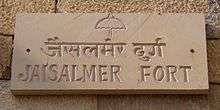
Built in 1156 by the Bhati Rajput ruler Jaisal, Jaisalmer Fort, situated on Meru Hill and named as Trikoot Garh has been the scene of many battles. Its massive sandstone walls are a tawny lion colour during the day, turning to a magical honey-gold as the sun sets. The famous Indian film director Satyajit Ray wrote a detective novel and later turned it into a film − Sonar Kella (The Golden Fortress) which was based on this fort. This is a living fort and about a quarter of city's population still live inside the fort. The main attractions inside the fort are: Raj Mahal (Royal palace), Jain temples and the Laxminath temple.
Jain heritage of Jaisalmer
Jaisalmer has been enriched by its Jain community, which has adorned the city with beautiful temples, notably the temples dedicated to the 16th Tirthankara, Shantinath, and 23rd Tirthankara, Parshvanath.
There are seven Jain temples in total which are situated within the Jaisalmer fort built during 12th and 15th centuries. Among these temples, the biggest is the Paraswanath Temple; the others are Chandraprabhu temple, Rishabdev temple, Shitalnath Temple, Kunthunath Temple, and Shantinath Temple. Known for their exquisite work of art and architecture that was predominant in the medieval era the temples are built out of yellow sandstone and have intricate engravings on them.
Jaisalmer boasts some of the oldest libraries of India which contain rarest of the manuscripts and artifacts of Jain tradition. There are many pilgrimage centers around Jaisalmer such as Lodhruva (Lodarva), Amarsagar, Brahmsar and Pokharan.
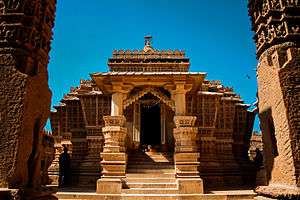 Lodhruva Jain Temple
Lodhruva Jain Temple- Chandraprabhu Jain Temple inside the Jaisalmer Fort
 Chandraprabhu idol inside Chandraprabhu Jain Temple of Jaisalmer Fort
Chandraprabhu idol inside Chandraprabhu Jain Temple of Jaisalmer Fort Jain Temple inside the Jaisalmer Fort
Jain Temple inside the Jaisalmer Fort Parshvantha, Lodhruva Jain Temple
Parshvantha, Lodhruva Jain Temple Shantinatha, Lodhruva Jain Temple
Shantinatha, Lodhruva Jain Temple- Ceiling of Jain temple inside the Jaisalmer Fort
 Carving on the wall of Jain Temple, Jaisalmer Fort
Carving on the wall of Jain Temple, Jaisalmer Fort
Museums
- Jaisalmer War Museum
- Desert Culture Centre & Museum
- Baa ri haveli culture centre and 450-year-old haveli in the fort
- Jaisalmer Folklore Museum.
- Government Museum
- Jaisalmer Fort Palace Museum
- Jaisalmer War Museum
- Akal Fossil Park Museums
- Cactus Park Museum, Kuldhara
- Tanot Museum, Tanot
Other
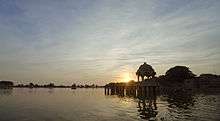
Ramdevra a village in Jaisalmer is named after Baba Ramdevji, a Tanwar Rajput and a saint who took Samādhi in 1384 CE, at the age of 33 years. He is worshiped today by many social groups of India as Ishta-deva.
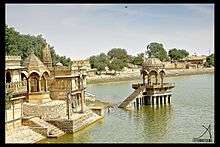
- Gadsisar Lake – Excavated in 1367 by Rawal Gadsi Singh, it is a scenic rainwater lake surrounded by the small temples and shrines of Amar Sagar. Earlier, this lake was used to be the main water source of Jaisalmer. Due to an increased water demand for agriculture, the lake is increasingly threatened to dry out.[11]
In neighbourhood
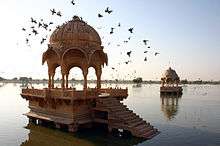
- Bada Bagh, a complex with chhatris of Jai Singh II (d. 1743) and subsequent Maharajas of Jaisalmer
- Lodhruva
- Desert National Park
- Bhaniyana
- Lanela
Desert festival
Desert Festival of Jaisalmer is the most awaited and famous cultural and colourful events that dominate the sand of Rajasthan and Camel races, turban tying competitions are organized. It is held in the month of February every year in Rajasthan. The desert festival in Jaisalmer has showcased Rajasthani folk songs and dance so it is a very attracted festival for foreign tourists. The rich culture of the region is on display during this three-day long festival. This is the best time to visit Jaisalmer to witness performing arts like Kalbelia dances and folk songs and music.
A person will never forget the famous Gair and Fire dancers which are the major attraction of the Jaisalmer desert festival celebrations. Interesting contests including a Mr. Desert contest and a turban tying competition enhance the fun of the occasion.
See also
- Paramara Dalvi-Deshmukh of Nasik originating from Jaisalmer
- Indira Gandhi Canal
- Pokhran
- Baba Ramdevji
- Tanot Mata
Cultural references
- Sonar Kella (1974) (Golden Fortress) Satyajit Ray's Bengali film, based on his eponymous novel featuring his creation, the detective Feluda, was based in Jaisalmer and surrounding areas.[12][13]
- Soul of Jaisalmer (Hindi nonfeature film 2016)(Universal certificate) Directed by Abenezer Inder. This film is based on traditional water step well of Jaisalmer and was filmed in Gadsisar, Amar Sagar, Bada Bagh and many more far location of Jaisalmer.
 Full shot of documentary film soul of Jaisalmer [2016]
Full shot of documentary film soul of Jaisalmer [2016]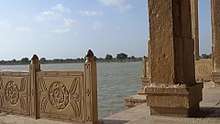 Shot of documentary film soul of Jaisalmer [2016]
Shot of documentary film soul of Jaisalmer [2016]
- Baa ri haveli 450 year old haveli in Jaisalmer fort
Further reading
- Bhati, Hari Singh. 2002. ANNALS OF JAISALMER: A Pre-Mediaeval History. Kavi Prakashan, Bikaner.
- Gahlot, Sukhvirsingh. 1992. RAJASTHAN: Historical & Cultural. J. S. Gahlot Research Institute, Jodhpur.
- Somani, Ram Vallabh. 1993. History of Rajasthan.
- Tod, James & Crooke, William. 1829. Annals & Antiquities of Rajasthan or the Central and Western Rajput States of India. 3 Vols. Reprint: Low Price Publications, Delhi. 1990. ISBN 81-85395-68-3 (set of 3 vols.)
References
- ↑ Balfour, Edward (1885). The encyclopædia of India and of Eastern and Southern Asia:. Original from Oxford University: B. Quaritch. p. 406.
- ↑ "India Meteorological Department – Weather Information for Jaisalmer". Worldweather.wmo.int. Retrieved 12 October 2012.
- ↑ "Border areas in Jaisalmer boil at 50°C, no respite in city". The Times of India. 2010-05-27.
- ↑ "Archived copy". Archived from the original on 26 December 2009. Retrieved 23 December 2009.
- ↑ Singh, Anuradha (2016-05-02). "Blistering Heat Wave Continues Across India; Jaisalmer Swelters At 52.4 Degrees". Topyaps.com. Retrieved 2016-08-05.
- ↑
- ↑ Archived 30 June 2006 at the Wayback Machine.
- ↑ "Desert Drummers". Caravanmagazine.in. 27 August 2013. Retrieved 15 September 2018.
- ↑ Sandip Roy, Special to The Chronicle (2008-07-05). "Queen H A R I S H". Queen-harish.blogspot.com. Retrieved 2012-08-19.
- ↑
- ↑ "Jaisalmer, Rajasthan - Don't Complain Travel". Dont-complain.com. 6 March 2014. Retrieved 15 September 2018.
- ↑ "Sonar Qila". Financial Express. 9 January 2004.
- ↑ Jaisalmer Photos Archived 18 December 2012 at Archive.is
External links
| Wikimedia Commons has media related to: |



